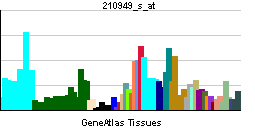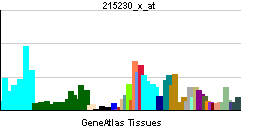EIF3C
| Eukaryotic translation initiation factor 3, subunit 8, 110kDa | |||||||||||
|---|---|---|---|---|---|---|---|---|---|---|---|
| Identifiers | |||||||||||
| Symbols | EIF3S8 ; eIF3-p110; eIF3c | ||||||||||
| External IDs | Template:OMIM5 Template:MGI HomoloGene: 2781 | ||||||||||
| |||||||||||
| RNA expression pattern | |||||||||||
 | |||||||||||
 | |||||||||||
 | |||||||||||
| More reference expression data | |||||||||||
| Orthologs | |||||||||||
| Template:GNF Ortholog box | |||||||||||
| Species | Human | Mouse | |||||||||
| Entrez | n/a | n/a | |||||||||
| Ensembl | n/a | n/a | |||||||||
| UniProt | n/a | n/a | |||||||||
| RefSeq (mRNA) | n/a | n/a | |||||||||
| RefSeq (protein) | n/a | n/a | |||||||||
| Location (UCSC) | n/a | n/a | |||||||||
| PubMed search | n/a | n/a | |||||||||
Eukaryotic translation initiation factor 3, subunit 8, 110kDa, also known as EIF3S8, is a human gene.[1]
References
Further reading
- Asano K, Kinzy TG, Merrick WC, Hershey JW (1997). "Conservation and diversity of eukaryotic translation initiation factor eIF3". J. Biol. Chem. 272 (2): 1101–9. PMID 8995409.
- Méthot N, Rom E, Olsen H, Sonenberg N (1997). "The human homologue of the yeast Prt1 protein is an integral part of the eukaryotic initiation factor 3 complex and interacts with p170". J. Biol. Chem. 272 (2): 1110–6. PMID 8995410.
- Block KL, Vornlocher HP, Hershey JW (1998). "Characterization of cDNAs encoding the p44 and p35 subunits of human translation initiation factor eIF3". J. Biol. Chem. 273 (48): 31901–8. PMID 9822659.
- Loftus BJ, Kim UJ, Sneddon VP; et al. (1999). "Genome duplications and other features in 12 Mb of DNA sequence from human chromosome 16p and 16q". Genomics. 60 (3): 295–308. doi:10.1006/geno.1999.5927. PMID 10493829.
- Morris-Desbois C, Bochard V, Reynaud C, Jalinot P (1999). "Interaction between the Ret finger protein and the Int-6 gene product and co-localisation into nuclear bodies". J. Cell. Sci. 112 ( Pt 19): 3331–42. PMID 10504338.
- Strausberg RL, Feingold EA, Grouse LH; et al. (2003). "Generation and initial analysis of more than 15,000 full-length human and mouse cDNA sequences". Proc. Natl. Acad. Sci. U.S.A. 99 (26): 16899–903. doi:10.1073/pnas.242603899. PMID 12477932.
- Olsen DS, Savner EM, Mathew A; et al. (2003). "Domains of eIF1A that mediate binding to eIF2, eIF3 and eIF5B and promote ternary complex recruitment in vivo". EMBO J. 22 (2): 193–204. doi:10.1093/emboj/cdg030. PMID 12514125.
- Mayeur GL, Fraser CS, Peiretti F; et al. (2003). "Characterization of eIF3k: a newly discovered subunit of mammalian translation initiation factor elF3". Eur. J. Biochem. 270 (20): 4133–9. PMID 14519125.
- Ota T, Suzuki Y, Nishikawa T; et al. (2004). "Complete sequencing and characterization of 21,243 full-length human cDNAs". Nat. Genet. 36 (1): 40–5. doi:10.1038/ng1285. PMID 14702039.
- Brandenberger R, Wei H, Zhang S; et al. (2005). "Transcriptome characterization elucidates signaling networks that control human ES cell growth and differentiation". Nat. Biotechnol. 22 (6): 707–16. doi:10.1038/nbt971. PMID 15146197.
- Colland F, Jacq X, Trouplin V; et al. (2004). "Functional proteomics mapping of a human signaling pathway". Genome Res. 14 (7): 1324–32. doi:10.1101/gr.2334104. PMID 15231748.
- Beausoleil SA, Jedrychowski M, Schwartz D; et al. (2004). "Large-scale characterization of HeLa cell nuclear phosphoproteins". Proc. Natl. Acad. Sci. U.S.A. 101 (33): 12130–5. doi:10.1073/pnas.0404720101. PMID 15302935.
- Gerhard DS, Wagner L, Feingold EA; et al. (2004). "The status, quality, and expansion of the NIH full-length cDNA project: the Mammalian Gene Collection (MGC)". Genome Res. 14 (10B): 2121–7. doi:10.1101/gr.2596504. PMID 15489334.
- Kim JE, Tannenbaum SR, White FM (2005). "Global phosphoproteome of HT-29 human colon adenocarcinoma cells". J. Proteome Res. 4 (4): 1339–46. doi:10.1021/pr050048h. PMID 16083285.
- Gevaert K, Staes A, Van Damme J; et al. (2006). "Global phosphoproteome analysis on human HepG2 hepatocytes using reversed-phase diagonal LC". Proteomics. 5 (14): 3589–99. doi:10.1002/pmic.200401217. PMID 16097034.
- Rual JF, Venkatesan K, Hao T; et al. (2005). "Towards a proteome-scale map of the human protein-protein interaction network". Nature. 437 (7062): 1173–8. doi:10.1038/nature04209. PMID 16189514.
- Oh JH, Yang JO, Hahn Y; et al. (2006). "Transcriptome analysis of human gastric cancer". Mamm. Genome. 16 (12): 942–54. doi:10.1007/s00335-005-0075-2. PMID 16341674.
- Beausoleil SA, Villén J, Gerber SA; et al. (2006). "A probability-based approach for high-throughput protein phosphorylation analysis and site localization". Nat. Biotechnol. 24 (10): 1285–92. doi:10.1038/nbt1240. PMID 16964243.
- Olsen JV, Blagoev B, Gnad F; et al. (2006). "Global, in vivo, and site-specific phosphorylation dynamics in signaling networks". Cell. 127 (3): 635–48. doi:10.1016/j.cell.2006.09.026. PMID 17081983.
| This protein-related article is a stub. You can help Wikipedia by expanding it. |